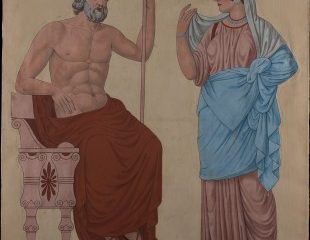
The return of Persephone
Copy of the lost Campanari tomb of Vulci restored
Vatican Museums Conference Hall – in person and live streaming
The first appointment of the year of the Thursday in the Museums programme is dedicated to the presentation of the restoration of a copy of the Campanari tomb of Vulci. After approximately 75 years, the extraordinary example of an early Hellenistic painting from Vulci, the original of which was completely destroyed immediately after its discovery due to an unsuccessful attempt to detach the wall paintings, is back on permanent display at the Gregorian Etruscan Museum.
From the Campanari tomb, dating from the late fourth to the third century B.C., and discovered in 1833 by Secondiano Campanari, to whom it owes its name, only a pictorial copy from life remains, made by the painter and archaeologist Carlo Ruspi, depicting Hades and Persephone. Of the remaining pictorial cycle of the Etruscan tomb, only drawings are preserved.
Carlo Ruspi’s work is closely linked to the intention to document and preserve for future generations the examples of Etruscan painting discovered from the 1820s in Tarquinia and later in Vulci. This artist and archaeologist, as he defined himself, left his name linked to the cycle of reproductions still conserved in the Gregorian Etruscan Museum, effectively starting the season of facsimiles.
The Gregorian Etruscan Museum still holds in its collections the complete reproductions of no less than six Tarquin tombs, the partial reproduction of the Campanari tomb at Vulci, and the copy of the complete pictorial cycle of the François tomb at Vulci, discovered in 1857 and produced by the artist in 1862, a year before his death. These valuable facsimiles, all executed in tempera on paper, were for more than a century a distinctive element of great value in the Vatican collection, before being transferred to storage in the early 1950s, precisely because of their documentary importance. The reproductions represent paintings that are now lost or damaged.
Finally, the panel with Hades and Persephone, carefully restored and mounted onto a suitable support to guarantee its isolation and protection, is once again visible to visitors as a pilot project in the field of conservation and museography. The aim is to recover, via the Ruspi copies, also other valuable reproductions of pictorial cycles, thus restoring to the Gregorian Etruscan Museum one of its original distinctive features.
The meeting will be introduced by the Director of the Vatican Museums, Barbara Jatta, and will include interventions from Maurizio Sannibale, Curator of the Department of Etrusco-Italic Antiquities; Chiara Fornaciari da Passano, Head of the Paper Restoration Laboratory; Flavia Serena di Lapigio, restorer of the Ethnological Materials Restoration Laboratory, and Marco Innocenzi, restorer of the Painting and Wood Materials Restoration Laboratory.
Thanks to the synergy and multidisciplinary approach of the various laboratories of the Vatican Museums, each of which has contributed decisively to the final result, it has been possible to achieve an excellent presentation of the Etruscan tomb.
The conference will be followed by a visit to the Gregorian Etruscan Museum, where the conservation intervention will be presented.





























